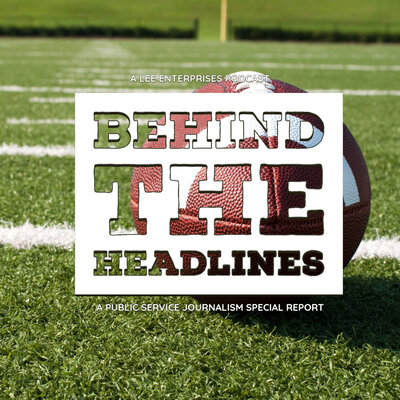
Behind the Headlines
Behind the Headlines features interviews with reporters and editors from newspapers owned by Lee Enterprises, including its Public Service Journalism team. Lee Enterprises is a leading provider of local news and information, and a major platform for advertising, with daily newspapers, rapidly-growing digital products, marketing services, innovative technology and nearly 350 weekly and specialty publications serving 77 markets in 26 states.
Most Recent Episode

Arizona's Hidden Faith: Allegations of Abuse and Control
In this gripping episode of Behind the Headlines, host Dean Hoffmeyer is joined by public service journalism reporter Emily Hamer to delve into a series of investigative reports on a controversial religious community in Tucson, Arizona. The Golden Dawn Tabernacle, a church for the followers of William Branham's "The Message," faces allegations of cult-like behavior, abuse, and cover-ups.
Emily shares insights from her team's investigation into the church's practices, including strict rules for members, particularly women, and the disturbing reports of excommunication and family separation. She uncovers the dark history of a related trailer park commune in Prescott, Arizona, where children faced brutal punishment and abuse.
Show notes created by https://headliner.app
More Episodes

Investigating Police Shootings of Native Americans in South Dakota
Welcome to Behind the Headlines, a Lee Enterprises podcast, where we feature news journalists discussing a variety of stories.
In this latest episode, host Faith Dey speaks with Ted McDermott, a reporter for the Lee Enterprises Public Service Journalism team.
Ted has spent over a year investigating the high rates of fatal encounters between Native Americans and local law enforcement, particularly on and off tribal lands in South Dakota.
Ted's investigation delves into the alarming statistics that show Native Americans in the region die from police encounters at rates significantly higher than their white counterparts. He discusses the systemic issues, including underfunding of tribal law enforcement and lack of transparency, which contribute to these tragic outcomes.
One poignant story highlighted is that of Weldon Poor Bear, whose son Adam was shot by Rosebud Sioux tribal police, leaving Weldon with unanswered questions about the circumstances of his son's death.
__________
Thank you for joining this latest episode. If you appreciate what we're doing with this program, please take a moment to subscribe and leave a review.
We especially encourage you to invest in local journalism by supporting the newspaper in your community. Lee Enterprises produces many national, regional, and sports podcasts. Learn more here.

Finding solutions to replace lead water pipes
Lead pipes have been banned since the 1980s, but millions of residents in Illinois and across the Midwest remain exposed to lead from water lines — and the prospects for equitable and quick remediation for low-income families and people of color could be dimming, a Lee Enterprises examination of public records and interviews shows.
Read the full story here and listen to a conversation with reporter Lauren Cross, who provides additional details about the problem and potential solutions.
About this program
Host Terry Lipshetz is a senior producer for Lee Enterprises. Besides producing interviews for this Behind the Headlines program, he produces the daily Hot off the Wire news podcast, co-hosts Streamed & Screened movies and television program and is the producer of Across the Sky weather and climate podcast.
Lee Enterprises produces many national, regional and sports podcasts. Learn more here.

North Carolina nurse accused of killing patients with lethal doses of insulin
Welcome to another episode of Behind the Headlines, where we feature experts and journalists discussing a variety of topics.
In this latest episode, Virginia Annable, a reporter for Lee Enterprises Public Service Journalism team based in Hickory, North Carolina, discusses her story about Johnathan Howard Hayes, a nurse in Winston-Salem, North Carolina.
Hayes stands accused of murder and attempted murder of patients in a hospital where he worked. Hayes is accused of intentionally administering a near-lethal dose of insulin to a patient in the same year he was nominated to be a nurse of distinction.
He is also accused of administering similar lethal doses of insulin to two other patients in early 2022, killing both, according to Winston-Salem police. Hayes was arrested in October 2022, on one count of attempted first-degree murder and two counts of murder.
Read the story
NC nurse accused of killing 2 patients was family man with history of medicine mismanagement
About this program
Host Terry Lipshetz is a senior producer for Lee Enterprises. Besides producing interviews for this Behind the Headlines program, he produces the daily Hot off the Wire news podcast, co-hosts Streamed & Screened movies and television program and is the producer of Across the Sky weather and climate podcast.
Lee Enterprises produces many national, regional and sports podcasts. Learn more here.
Episode transcript
Note: The following transcript was created by Headliner and may contain misspellings and other inaccuracies as it was generated automatically:
Terry Lipshetz: Welcome to another episode of behind the Headlines, where we feature experts and journalists discussing a variety of topics. I'm Terry Lipshetz, a senior producer for Lee Enterprises, and your host in this latest episode, Virginia Annable, a reporter for Lee Enterprises public service journalism team based in Hickory, North Carolina, discusses her story about Jonathan Howard Hayes, a nurse in Winston Salem, North Carolina, who is accused of killing two patients with fatal doses of insulin. Hayes was arrested in October 2022 on one count of attempted first degree murder and two counts of murder. Virginia, welcome to the program.
Virginia Annable: Thank you for having me.
Terry Lipshetz: Can you talk a little bit about the case, what exactly happened and where things stand at the moment?
Virginia Annable: Sure, yeah. This case came to public attention in October 2022, when the district, attorney of Forsyth County and the atrium, Wake Forest Baptist Hospital, came out with a press conference and announced that they had arrested Jonathan Howard Hayes. He was a nurse at Wake Forest, and he was accused of killing two patients and attempting to kill a third. Since then, there hasn't been a lot of movement in the case, but it really caught the public's attention. Just the fact that there was this nurse who lived in the community, had been a nurse for 20 years, on the surface, seemed like everything was right. And then they were accusing him, of some pretty horrific things. So it really caught the attention of the whole state with these accusations.
Terry Lipshetz: Has there been a trial date yet? What's the status?
Virginia Annable: He has only appeared in court for his first appearance. They gave him no bond. And since then, there's been a couple dates set for an appearance. And it just keeps getting pushed back. It's really gotten dragged out. I mean, it's been almost a year now and, there's been very little movement on it.
Jonathan Hayes is accused of killing two patients with lethal doses of insulin
Terry Lipshetz: You talk a little bit about the two patients that died and also the one that survived, but what was the cause of death and what is he essentially being accused of here?
Virginia Annable: The hospital gave a really thorough timeline and a lot of information into the police, and that was all detailed in the search warrant application. So we have a really good look at what happened and what the hospital is saying. Their investigation found the first accusation was Pamela Jean Little. In December of 2021, she had an overdose of insulin and had a hypoglycemic event, which is when their blood sugar drops very, very low and it can cause a coma or death. Little was lucky enough to survive, but the accusation is that Jonathan Hayes overdosed her with potentially 100 units of insulin. When the typical, largest amount you would get is twelve. Then the second patient is Gwenda Zelda Crawford. And on January 5, at least, the doctors say that she had an overdose of about 100 units of insulin. She went into a coma. They took her to the ICU. Ah. But she unfortunately passed away a few days later. And then there was a third patient, Vicky Lynn Lingerfeld. And on January 22, she also had a hypoglycemic event where her blood sugar just dropped out. They did the blood test. They believe it was again over 100 units of insulin. And she went to the ICU, but she also passed away a few days later. The documents and all the hospital investigation found that Hayes was the only nurse present at all three events.
Terry Lipshetz: In your reporting, it mentions that Hayes administered seven times more insulin than others at the hospital. Can you talk a little bit about that finding?
Virginia Annable: So it sounds like after these three events, the hospital started looking into it and realized there was something wrong. And, then they kind of found the link to Hayes. And once they saw that, they did investigation into his medication usage and the amount of insulin he was using. And it's really interesting, the number that they found was he was the top administrator of insulin in the entire hospital. It's a very big hospital of any employee for a three month period. And he was also administering seven times the average of the whole hospital staff. So for how much insulin? Everyone the average of what everyone was administering, he was typically administering, like, seven times that. So there's a pretty big indication that there are some issues with medication administration. There is also some it's a little bit more tricky to explain, but the way that he was supposed to be verifying, medication administration, he was oftentimes saying it was given by other instead of putting a specific name down when administering medication. The hospital says that of the 130 times that given by other was used during medication administration, he did it 88 times. And that's for the entire hospital.
What is the dual verification process for certain medications?
Terry Lipshetz: Yeah, I wanted to follow up on that a little bit, because in your story, you talked a little bit about a dual verification process. So the idea being that with certain medications or maybe all medications, when a nurse is about to administer it, somebody else is there. Can you talk a little bit about that and what the expectation is under normal circumstances?
Virginia Annable: Yeah. So with hospitals, certain medications they call high alert. Medications that are maybe like an opiate or something like insulin that's more regulated. Nurses or doctors, et cetera, are required to have two people present and two people verify that this dose is acceptable and this is how much we're giving to the patient. There is a small way to get around that. And that's the given by other designation, which is typically reserved for, like, if there's an emergency or someone gave the patient the medication while they were getting an X ray or just something a little bit out of the ordinary where it might be harder to get that dual verification. But then medication was needed. But it seems very rarely used.
Terry Lipshetz: So under a normal circumstance, if a patient's in a hospital room and there's nothing else crazy going on, the expectation would be there'd be a dual verification and not just given by just one person.
Virginia Annable: Not just one person and given by other. Like, there's two medical personnel who kind of sign off on it.
What is a risk management team at hospital?
Terry Lipshetz: You mentioned a little bit, too, about the risk management team at the hospital. What exactly is that, and what's the function?
Virginia Annable: The risk management team, they kind of look into when the, hospital staff or anyone kind of says, there's a problem here. So in this case, they saw a pattern of these hypoglycemic episodes, and the risk management team steps in and does an evaluation, and they actually have a whole form that they fill out for each event and what happens, and they go as far to interview employees, and they check all of the records related to it. And they were, like, a full system check of what nurses were accessing, what information related to the incident. it's pretty interesting, just the amount of detail that they looked into. And the risk management team was able to meet with the police and turn over all of that information. And so the police can investigate from there and kind of verify everything they found.
Terry Lipshetz: Once this risk management team discovered there were some issues here with this case in particular, what did they do?
Virginia Annable: It sounds like as soon as they realized there was an issue, hayes was let go. And that was in late March of 2022. So a couple of months after the second death in January, they assessed the situation, and then the hospital let Hayes go. And then probably two I think it was three days after Hayes was let go, they met with the Winston Salem Police Department to let them know about these concerns. And the police department opened the investigation from there.
Terry Lipshetz: There was a sidebar that goes with the story as well. Now, you didn't write this. It's written by, Kate Farrish, but I know you've got some insight into this as well. And it gets into insulin. So it mentions that there is a former nurse, from West Virginia that's currently serving life in prison for killing seven elderly veterans. there is a registered nurse accused of killing two patients, at a Pennsylvania nursing home. There's another nurse that's been charged with killing patients. The common link here is insulin. What is it about insulin that has become such a common thread in some of these cases where a medical provider is being accused or convicted in a murder?
Virginia Annable: Yeah, that was something that kind of stood out to us and made us want to look into it. And that's why we had Kate Ferriss do a great story on that. And one of the things that we found just talking to some experts was that insulin, while it is a high alert medication, often still doesn't have that barrier to access as maybe an opioid or some other medication that's more highly regulated or has more street value, which is someone can't necessarily walk out of, the hospital and sell insulin for a lot of money like they could with other drugs. So that means a lot of times it looks like the insulin is easier for nurses to access. They can get more of it in some instances, like the medication carts were left unlocked or easy to get to, even if someone wasn't supposed to have access to that medication. So it's really just, the barrier to access is a lot lower with insulin.
Terry Lipshetz: And it would also seem, too, that because of the nature of diabetic patients, it's possibly a little bit easier to get around. Too right, because you have to give it at certain intervals, depending on when a patient might need it. And it's a very unique thing.
Virginia Annable: It can be left up to the provider to decide if that patient needs it as well. So, that decision can land on one person, and they can say, this person blood sugar looked like they needed insulin. So there's a little more flexibility where there isn't as much with higher level medications. But this insulin obviously can still lead to death and can, cause comas and a lot of health issues.
Terry Lipshetz: Another interesting point, too, is that for teams at hospitals, or looking at maybe misuse of medications, and the various safeguards that are in place, is not necessarily about catching someone who's maybe trying to cause harm, but maybe about catching mistakes, like medication errors more than anything. Too so is that part of the problem here, or is it just yeah.
Virginia Annable: That was something that we noticed when we saw this link of insurin and these apparently intentional deaths. We thought we would try to talk to hospitals about what they're doing that could potentially catch that. and when we looked into those regulations or steps that hospitals take, it's not about catching someone who's intentionally doing this. Many of their backstops are about mistakes, medical mistakes, which is, on one hand, you're like, okay, that's probably more common. But then we see these lengths, and you just get a little curious what could have caught these people. A lot of the hospitals weren't willing to talk about catching killers in their hospitals know, they just say they're looking for those medical mistakes. But there was an instance in West Virginia, in the VA. And a VA hospital where there were some intentional killings. There was a report afterwards kind of talking about some of the problems of what could have prevented this, what could have been done. And one of the big things that they pointed out was that when doctors and investigators kind of looked into these deaths, their thought wasn't necessarily, this was intentional. This was someone trying to kill people. Their thought was, this is a medical error, or, there's something wrong with the system, that kind of thing. So it doesn't seem like it's top of mind in these regulations to be catching someone who's intentionally killing people in hospitals.
Has there been any discussion about how insulin should be regulated?
Terry Lipshetz: Has there been any discussion, or did you find anything during your reporting where there's maybe some consideration into, looking at how insulin is regulated? Or is that not something that's widely discussed yet?
Virginia Annable: We don't see a lot of discussion about it in these ancient years where it happened, where someone's loved one was killed by insulin. Those people are advocates for there being more regulation. But regulation of insulin and of medication is so, different in each state and different hospital to hospital. There's not a lot of regularity between how it is administered and how it is regulated and how it's documented and that kind of thing, which was kind of an interesting part of Kate's story, just that there are some recommendations. There are advocacy groups that say this is how you should be documenting medication, and this is how you should be keeping it safe. But, it's really often left up to a hospital. The state or Medicaid agencies say you have to have dual verification for insulin, say, but they don't say how it has to be done, whether it has to be done electronically or your medication has to be locked up, but it could be in a cart, or it could be in a room and that kind of thing. So there's a lot of variability, from hospital to hospital.
In the Hayes case, if the accusations are true, it would meet the definition of serial killer
Terry Lipshetz: You talked a little bit in your story about the definition of serial killers, because in this case, in the Hayes case, if the accusations are true, it would meet the FBI's definition of a serial killer. Can you talk a little bit about that?
Virginia Annable: Yeah, I started looking into that. I spoke with a criminologist who said I should check that. The old definition was that it was three deaths across, a month or more. But the FBI has changed the definition now to be two intentional killings in separate instances. so there's not as much of a timeline. And so under that these deaths in the hospital do meet that definition of two or more deaths in separate instances. And including the instance with little it was over about two months that these happened.
Terry Lipshetz: What's next in the case? Where do things stand? You know, is there anything else you're looking into?
Virginia Annable: Whenever the case was announced, the DA asked hospitals to check their records and make sure know they don't see any other suspicious events or suspicious deaths if like, Hayes was working there. so I'm curious to see if anything like that does pop up. I know these investigations can take a long time, so even if a hospital did see an incident and reach out to investigators, it could take some time before we actually see if there are other linked cases. So far, there aren't any. And at least one of the hospitals I reached out to where Hayes had worked said that they immediately checked their records and tried to see how long he worked there, who he was working with, if he was ever alone administering medication. so I'm sure a lot of those hospitals did the exact same thing. It'll be interesting to see where this case goes. There's two sides to every story, so I'm not sure if this case will play out in court and we'll get to hear more or if it will end up being a plea deal. I think it will take some time. I spoke to his lawyer just to see if we could talk to Hayes or talk to him about the case. and he declined to comment. But he did say just to remember, there's two sides of the story, so we'll really see how everything plays out, hopefully, in the next couple months.
Terry Lipshetz: With Hayes, he did work at multiple hospitals, right? He hadn't been at that hospital for a very long time. He had moved around from place to place. So there is that potential then, that multiple places. Do you know exactly how many, medical, facilities he had worked at prior?
Virginia Annable: Yeah, based on his resume, which was given to police by, adrian Way Forest, he had worked at potentially like six or seven other hospitals, and all kind of in the central North Carolina area. There's a couple state hospitals there's, private hospitals. And a lot of them have kind of merged or changed over the last 20 years. So it sounds like they're, really having to dig through their records to figure out where he worked and when, and try to line that up. But, yeah, it does look like it's about seven hospitals, possibly, but it could be more or less. That was just based on a resume he gave to the hospital. He did work atrium Wake Forest for, I think, at least 15 years, but it was kind of on and off.
Terry Lipshetz: Virginia, thank you so much for joining me today and talking about this topic.
Virginia Annable: No problem. Thank you so much.
Terry Lipshetz: We hope you enjoyed this latest episode of behind the Headlines. You can find us on every podcast platform, and we'd love it if you could take a moment to subscribe and leave a review. Finally, if you appreciate what we're doing with this program, we encourage you to invest in local journalism by supporting the newspaper in your community. I'm Terry Lipshetz, thanking you so much for listening to behind the Headlines from Lee Enterprise.
See omnystudio.com/listener for privacy information.

Universities, apparel companies make millions from clothing made for poverty wages
Welcome to another episode of Behind the Headlines, where we feature experts and journalists discussing a variety of topics. In this latest episode, Hayleigh Colombo, a reporter for Lee Enterprises Public Service Journalism Team, talks about her story on logo apparel for colleges and the labor that is being used to produce the clothing.
Read the story
Broken threads: College clothing made in factories rife with labor violations, poverty wages
About this program
Host Terry Lipshetz is a senior producer for Lee Enterprises. Besides producing interviews for this Behind the Headlines program, he produces the daily Hot off the Wire news podcast, co-hosts Streamed & Screened movies and television program and is the producer of Across the Sky weather and climate podcast.
Lee Enterprises produces many national, regional and sports podcasts. Learn more here.
Episode transcript
Note: The following transcript was created by Adobe Premiere and may contain misspellings and other inaccuracies as it was generated automatically:
Terry Lipshetz: Welcome to another episode of behind the Headlines, where we feature experts and journalists discussing a variety of topics. I'm Terry Lipshetz, a senior producer for Lee Enterprises and your host in this latest episode, Haley Colombo, reporter for Lee Enterprise's public service journalism team, talks about her story on logo apparel for colleges and the labor that is being used to produce the clothing. Haley, welcome to the program.
Hayleigh Colombo: Thanks so much for having me.
Terry Lipshetz: Hayleigh, can you provide just an overall synopsis of what this story is about? Because it felt like there was a lot of pieces in it.
Hayleigh Colombo: I think it's important for people to know when they go to the university bookstore on football Saturday and they're buying a new T shirt or whatever to represent their favorite team, I think we make a lot of those buying decisions and don't necessarily think about what all went into it. What all went into making that shirt that is now on, the rack at my favorite university and being sold for $30 or whatever. $25. And what all went into it is this incredibly it takes an incredibly complex global labor supply chain to make those clothes, to bring them to consumers. And the reality is that the people who had the hardest job in making that shirt were compensated leap. And often those workers are getting poverty level wages that are hard for them to subsist on in their home countries making the US equivalent of a dollar 2 /hour which is even in countries where it costs less. To live or the expenses are less. It's still not enough for them to have a good life, to have the even calories that they need to subsist on. And there's lots of abuses that take place in these apparel factories, whether it's people not having the right to form a union or, when they try to form a union being retaliative against for that, sexual harassment, wage theft. And our universities, which are some of our most well known brands and most important institutions in this country, they themselves are, profiting off of this system because they earn millions of dollars of royalties from the sale of this gear. So we wanted to kind of delve into the conditions that this year is being made under and delve into what, if anything, universities have done, are doing to ensure that the people who actually make the garments with their logos on it are being treated fairly.
Terry Lipshetz: You had an interesting anecdote early in the story about a factory worker from Honduras. Can you talk a little bit about that example that you used about the working conditions and his wages?
Hayleigh Colombo: Yeah, absolutely. So I spoke with famous demas Michael Cardona Bar, and he is a worker in a factory that makes Nike gear. so he had recently worked on a University of Arizona alumni t shirt that Nike is selling for or that the university bookstores or retailers are selling for $35. He has to make upwards of works on upwards of, like, 750 to 1000 of those shirts a day, and he makes the equivalent of $97 a week. essentially that shirt, college football fans who are buying that shirt are paying more for it than he makes in a single day. And I think it's important to understand that that wage is not adequate for him to have a middle class lifestyle. He struggles to make ends meet, even though his wife is working. He has two young kids. One of his kids is a little bit younger than one of mine. So we were talking about, you know, he said it's not enough money to maintain his, you know, brands like Nike are profiting handsomely off of the sale of this gear. brands and retailers like the markup on the shirt is about 70%. Meanwhile, workers earn 1% or less of the final cost of the shirt in workers like him. And advocates in this industry, advocates fighting for fair wages, have pointed out that brands and retailers could ensure that workers are being paid fairly. They're profiting handsomely off of it.
Terry Lipshetz: Did you get any feedback from apparel companies?
Hayleigh Colombo: They largely didn't want to talk about this issue. Nike didn't respond to multiple requests for comment, even, about specific issues that had come up in their other brands that we reached out to. Kind of sent back statements, I would say, about, oh, we care about their treatment of worker. And I don't want to say that they don't, but I think that they don't feel a lot of impetus, apparently, to change the situation. And there are a lot of people suffering under this system. Experts that I talked with, who study the global apparel industry have noted that, in order to pay workers a fair living wage for them, it would really not drastically impact the cost of a t shirt. Even if they pass 100% of the cost on to consumers. It would add, like a dollar or something like that. Obviously, you could debate whether consumers should pay the full cost of doing something like that, or brands and retailers should eat into their profit a little bit to cover that. But it wouldn't be a drastic investment that they would have to make in order to write the ship.
Terry Lipshetz: And, there's not really a lot of pressure, it seems, right now, to write that ship.
Hayleigh Colombo: There's been kind of waxing and waning pressure over the last several decades. There was in the early 2000s, when after US. Manufacturing of clothing declined, and more and more clothing started being manufactured overseas in these low wage countries, there was a big outcry about how apparel was being made. I don't know if people remember, like, Kathy Lee Gifford got into a lot of hot water back in the day for her clothing brand. And there have been various disasters have happened. Horrible disasters have happened over the years. In 2013, a Bangladesh building collapsed, it's kind of known as the Rana Plaza disaster. And more than 1000 people died, largely garment workers. And it's the worst disaster that the industry has ever known. So when situations like that happen, yes, there's a large outcry, but by and large, obviously there's really not. Consumers are kind of going about their day, consumers are cash strapped as well. I'm in the same way, I'm not trying to pay as much as possible to buy a t shirt. You try to get the best thing you can for the least amount of money to fit in your budget. And I've talked with folks who have said it really shouldn't be on consumers, it should be on the brands and retailers, as well as the large institutional buyers like universities, or like professional sports teams who put that pressure on the brands and retailers to change their practices.
Terry Lipshetz: The fact that this story is about universities is interesting because obviously division, one level universities are big money makers with football programs and basketball programs, and it's not professional sports, but there's a lot of money in it, like professional sports, and you get crowds of 60,000, 70,000, 80,000 or more going to football games. So it's a huge industry. But at the same time, many of these large schools are also research universities. They study things like labor practices. And it's kind of an interesting situation. So what kind of responsibility do universities bear here?
Hayleigh Colombo: It's so interesting. And one of the reasons why we focused on university gear when this problem exists across all apparel, every time you buy a shirt that insert retailer of your choice, the same issues are at play. The difference with the university apparel is that they are public facing, publicly funded, most of the time, obviously, there's private universities, but publicly funded by taxpayers, institutions of higher learning, where, like you're saying, some of the same institutions that have apparel that's being produced under unfair conditions, those same institutions have professors, there who are studying this issue. Experts have said that, universities do play a big role in trying to correct this. And to their credit, to the extent that anyone has tried to improve this, universities have. And so I talked to university officials too, who are kind of begrudging the fact that people are asking us to do more, but we're really the only folks who are doing anything right. What else can we do? What we discovered is the investment of time. The people who are really engaged in this, it's really not uniform across universities. There's a core group of universities who are really engaged in this work and really seem to care about it, and are trying to, use the leverage that they have. But there's a lot of universities, I would venture to say most based on our research, who don't appear to be engaged in this and are large, but themselves could play a role. Could be another voice asking brand of choice to ensure that workers are paid fairly.
Terry Lipshetz: Do sponsorships complicate the issue? Because you have like Nike and Adidas and all these brands will be the official shoe sponsor of such and such college football team or the basketball team or whatever. Are these relationships complicating the issue as well?
Hayleigh Colombo: Absolutely they are, because Nike, these other companies, depending on the school, they're paying a million dollars, multiple million dollars every year, in the form of these deals. And that really, I mean they're important business partners of the university. So it's tricky because it's this symbiotic relationship. What's worth more to the university, the deal being in good standing with Nike or appeasing, some students who know activists regarding sweatshop apparel.
Terry Lipshetz: Right. You had the interview with the worker from Honduras. You referenced the building collapse in Bangladesh. I know your story references a case in Bangkok, Thailand. Also, you have these factories in so many different countries. Is this complicating the situation as well? Because it's not like everybody is working in the same country and they're all making apparel in one place. So how is that complicating the situation?
Hayleigh Colombo: It's incredibly complicated. Honestly, researching this subject, my mind was truly blown about how complex the global supply chain is. I mean thousands of factories are involved. Schools have hundreds of licensees, who each have their own set of factories that they use. So it's really hard to track because it is very hard to know. I spent a lot of time trying to kind of track a specific shirt and find out which factory that shirt was made in. It is so hard to know. It's almost impossible to know. I was going through these importing logs, trying to find these shipments that would give any sort of clue about, okay, this factory had an order that came to the US with Adidas or Nike as the customer and what was in that order? And it'll just say like men's knit tops or something. And it's like, it's very hard to track. Or obviously any shirt that you're buying, it'll say, or piece of apparel that you're buying on the physical tag, it will know made in Honduras, made in Thailand, made in Bangladesh. But it doesn't give any more details, than there's, you know, hundreds, if not more factories in all these countries. So it's just really hard for folks to monitor. It's really hard for universities. I mean universities are not in the business of monitoring factories in Thailand. They're just not. So it's hard to know. And what makes it even more complicated is that brands themselves don't really own their own factories. That's not really a thing. They're all subcontractors. So it's like, okay, these are the hundreds of facilities. That where Nike gear is made. But it's not like these people are employees of Nike or employees of Adidas or Under Armour or whoever. So it makes it really hard to track, and it also makes it really hard for anyone to really, truly accept accountability for what happens in these places. Because the university can say, like, well, this was the brand that we worked with. And the brand can say, well, this is the Subcontractor that we use. and sometimes those subcontractors are their subcontracting out to other factories. So in the case of the Rana Plaza disaster, for instance, some brands were surprised that their gear was being made there. There was like, tags in the rubble and just some horrifying images where you would see this gear, this shirt was made there. And the brands themselves didn't even know because that was a, Subcontractor. Subcontractor was sewing the sleeves or something. And there's just tremendous, with an industry that fragmented, there's tremendous pressure on the factories themselves to have labor costs as low as possible.
Terry Lipshetz: I mean, you don't want to provide excuses for businesses, but in some ways, it's also difficult for them. They can claim like, well, we hired the Subcontractor and they say, we're operating on the up and up. But if they're not doing it because they're not employees of these manufacturers, then it is tougher for them to monitor too.
Hayleigh Colombo: Right? Absolutely, it absolutely is. I think that, advocates would say, well, yeah, it is tough, but it's also brands and retailers who have chosen to organize themselves this way, to chosen to use Subcontractors that they don't track very well. All of this is a choice, and it's a choice that's being made in search of higher and higher profits.
Terry Lipshetz: So what's next? Are you going to continue looking at this story? Are there other angles that you're pursuing?
Hayleigh Colombo: I hope so. Honestly, it's been so fascinating. It's really been so fascinating. I definitely want to keep reporting on it. I think that it's fascinating to see what, if any, solutions people have come up with. So one really fascinating past solution was that there was a fair trade university logo factory. It’s called alta gracias in the Dominican Republic. And universities, for a time being, when Alta Gracia was up and running, they would have displays in the store like, okay, all these people are, earning fair wages. They were like, on average, three times the minimum wage or something like that. They had union collective bargaining rights, they were working in good conditions. And that factory unfortunately, closed after COVID. And so what other that was obviously such a creative solution that it was kind of a private sector solution. And it did appear to make a difference, or at least show that this model could work. it successfully worked for many years, but the COVID pandemic was kind of the nail in the coffin there. In the past, there was an effort to have something called a designated suppliers program where it would really clamp down on the number of factories that did produce university logo gear so that the universities could have a really strong oversight of those factories and what went on there. And that was the solution that a lot of the really involved universities were really hoping for, but that ran into some US. Antitrust issues and never came to fruition. So what's the next, private sector creative solution? Is there government is there ever going to be government intervention to solve this problem, or is this just a problem that we've accepted as a society as kind of the cost of doing business? I hope not, because in the reporting, it became very clear to me people are really suffering for something, as simple as us being like, oh, yeah, I'll pick up a new t shirt, like a new alma mater T shirt. Like, there's really like, there's people who are behind that who are not living good lives, and that doesn't have to be true.
Terry Lipshetz: Well, on that note, Haley, appreciate you coming on today to talk about this and certainly going to think a little bit differently the next time I pick up local apparel from either a, pro or college team. And it does give me something to think about.
Hayleigh Colombo: Absolutely. Thanks so much, Terry.
Terry Lipshetz: We hope you enjoyed this latest episode of behind the Headlines. You can find us on every podcast platform, and we'd love it if you could take a moment to subscribe and leave a review. Finally, if you appreciate what we're doing with this program, we encourage you to invest in local journalism by supporting the newspaper in your community. I'm Terry Lipshetz. Thanking you so much for listening to behind the Headlines from Lee Enterprise.
See omnystudio.com/listener for privacy information.

Reducing public defender workloads across the nation
The American justice system guarantees a presumption of innocence and the right to legal counsel. For those that cannot afford an attorney, public defenders are available to provide a defense.
But a new report from Emily Hamer, a reporter for Lee Enterprises' Public Service Journalism team, reveals that public defenders across the country are overworked.
In the story "Public defenders work 3 times too many cases, milestone study and new data show," Hamer's research found public defenders across America regularly work triple the cases they can effectively handle, and some work upwards of 10 times too many cases, according to an analysis of Lee Enterprises data based on a milestone study of public defender workloads.
Lee Enterprises’ Public Service Journalism team requested caseload data from all 50 states to conduct the first-ever national analysis of public defender workloads using the new National Public Defense Workload Standards. The analysis proves public defenders are severely overworked — a problem that threatens the constitutional right to effective counsel.
In this episode of Behind the Headlines, Hamer discusses the story, consequences of ineffective counsel and potential solutions.
Read more
- Public defenders work 3 times too many cases, milestone study and new data show
- Broken defense: People’s right to counsel routinely violated across West
About this program
Host Terry Lipshetz is a senior producer for Lee Enterprises. Besides producing interviews for this Behind the Headlines program, he produces the daily Hot off the Wire news podcast, co-hosts Streamed & Screened movies and television program and is the producer of Across the Sky weather and climate podcast.
Lee Enterprises produces many national, regional and sports podcasts. Learn more here.
Episode transcript
Note: The following transcript was created by Adobe Premiere and may contain misspellings and other inaccuracies as it was generated automatically:
Welcome to another episode of Behind the Headlines, where we feature experts and journalists discussing a variety of topics. I'm Terry Lipshetz, a senior producer for Lee and your host. In this latest episode, Emily Hamer, a reporter for Lee Enterprises’ Public Service Journalism team, discusses her story “Public defenders work 3 times too many cases, milestone study and new data show.”
Emily, welcome to the program. Thanks so much for having me. Before we dive into this current story, this isn't something that's new to you. You've been working a little bit on public defender topics for a little while now. Can you talk a little bit about previous reporting you did for your series: “Broken Defense: People's right to counsel routinely violated across the West.”
In that series we really wanted to take a deep dive into what's happening into public defense systems across the U.S. and because I think we kind of everybody sort of assumes that public defenders are underfunded or they're not paid well and they're really overworked. But I think that people sense that's so commonly accepted. People don't really think it's a problem that we should actually try to fix.
So my series really sought out to examine that issue and look at how it's affecting real people's lives who are going through the criminal justice system. So we found people who lost jobs, lost homes while they were stuck in jail, while they're still presumed innocent, but they're waiting for an attorney to represent them. And there just wasn't one available.
That's happening in Oregon right now. There are also people who they plead guilty to misdemeanors before ever talking with a defense attorney at all because the the justice system is kind of set up to pressure them into pleading, pleading out their case and just getting it over and done with before they ever talk to that public defender, even though they have a constitutional right to that.
So we found about more than 100,000 misdemeanor cases each year where people go to jail without ever talking to a lawyer at all. And so we talked to a lot of people about how this broken system is affecting them and found that it's it's become really common, a really routine part of the criminal justice system for People's Sixth Amendment right to counsel, to be violated.
Don't want to go too far off track here, but what would the reasoning be to to plead out so quickly? Is prosecution just looking to turn over cases, especially lower level cases, a lot faster and kind of keep things moving along? Is that the reason for that then? Yeah, I mean, I do some of the people, some of the defendants who have been accused of crimes do see it as an advantage because they're able to just resolve their case and get it done with.
But some of those people might have wanted to fight their case. So in there was a court in Texas where I went to their initial appearance. Court and initial appearance is supposed to be where you go in front of the judge and you either have your bail set or your release to release from jail or given a signature bond to come back to court to to fight your case at another time.
Or you have to you were you were never in jail. So you are just kind of showing up to get things rolling on your case. So it's normally just kind of like a checkpoint hearing. But at this court, I went through in Texas, there were a ton of people who fled their cases on that very first day in court.
And there's no defense attorney or public defender at all in the courtroom to help them understand the consequences of pleading guilty to that misdemeanor. There was one guy who went before the judge and he had he was in jail for like a marijuana charge. And the judge asked him if he wanted to plead guilty to the charge. And the guy said, no, he didn't.
But then the prosecutor came back over and was like, well, no, what we talked about is if you plead guilty, you get out of jail today. And then the guy kind of flipped the switch and said that he does plead guilty now. So they're just talking with the prosecutor by themselves without any kind of counsel and without any understanding of the collateral consequences of pleading guilty to even just a minor crime.
Maybe they could have had a defense against that. But they never talked with a public defender to to find that out. It's interesting. So now moving on to the current story that you're working on. You know, first, I think most people listening to this probably have a basic understanding. But can you explain what exactly as a public defender, what is the role and how do they play a part in the justice system?
Yeah, So a public defender is an attorney who is appointed to your case when you can't afford to hire your own private attorney yourself. So they are provided to people, to people who are poor or they call them indigent in the criminal justice system when when they can't afford an attorney, you're provided an attorney to fight for your case at the state's expense.
And your constitutional right to an attorney is is not just to any public defender to just like sit by and watch your case, but to an effective public defender who actually fights for you. We're all entitled to an effective legal counsel, basically. Yes. So now what is this current story that you're working on in and what kind of data did it reveal?
This movement of people, lawyers and researchers who are trying to fix public defense systems? And they came up with these new metrics that are not allow anybody really to measure public defender workloads to find out how many cases is too many cases for a public defender to handle. So they want to make sure that public defenders are taking on because when a public defender takes on way too many cases, they can't be effective for every single one of those clients, every every person that they're representing, some cases get thrown to the wayside.
These new national public defense workload standards that have have come out are a way to kind of get public defender caseloads on the map and find out when there are way too many cases that a public defender is handling. So I took the those figures that kind of the big the big number there is that attorneys should never handle more than 59 low level felonies in a year.
And there there are 11 other figures like that. But that's kind of the the biggest one, I think, to wrap your head around. So I requested data caseload data from all 50 states in order to get an understanding of of where public defenders are at in terms of their caseloads. And I got data back from about 36 states, and it represents about 9000 public defenders and in 30 states.
And their average caseload were nearly three times the maximum that they were supposed to have under the new standards. And that's even under a conservative analysis. So basically, public defender workloads are really, really high, unreasonably high. And they have been for a really long time. But this these new standards and this new data is kind of the first nationwide analysis that really shows just how overworked they are.
So when you say upwards of three times as much, I mean, the standards are now saying no more than 59 low level felonies. So if they're going three times, you're looking at attorneys that are pushing, you know, closing in on 200 a year, then in some places it's even higher. Like in St Clair County in Missouri, the St Louis Post-Dispatch did a story where public defenders there had more than 350 felonies.
And in 2022, which is like six times too many cases, and that's that's assuming all of the felonies are are low level felonies. If they're mid-level felonies, you should only work 36 of them in a year. And that's assuming that you're working 2080 hours, which is 40 hours every week of the year without taking any vacations or sick time.
And you're spending and or doing administrative tasks like responding to e-mails where it's all piecework. So it really is a conservative analysis that show that shows that public defenders have tripled the cases they should. Yeah. And if it's based on 20, 80 hours, too, that's in a sense, a little bit unfair because we presumably all want to have a little time off.
I'm not sure we're all operating at peak levels when we're never getting a day off. So, yeah, for sure. My series I talked with one public defender in a rural California county and he said that he worked, I think it was something like every day, including weekends for the past three years, and he was taking a step down from one of his public defender positions because he he wanted a little bit of a break.
He got out of one of his contracts, but he's like, yeah, I can't work every single day anymore. So yeah. And there and I found in in Texas and Idaho and Maryland there were a handful of attorneys who had ten times too many cases according to the standards. Well, and one judicial circuit in Florida where attorneys had nine times too many cases.
There are some public defenders who are handling just a crazy number of cases, and they can't provide a rigorous defense to every single one of those clients. So it results in a system where some clients are getting this great defense. But then that's at the expense of these other cases that are just getting pushed through the system. You speak about like low level felonies and mid-level.
Can you just give some examples of what qualifies? I mean, I'm assuming obviously like a murder isn't going to be something that would fall under a lower, lower level felony. So can you just kind of give a sense of some of the crimes that would fall under each kind of grouping? Yeah, there's actually a separate Corey for murder cases and those you should only handle eight of those in a year and you should spend a around 250 hours on each of them.
So there's, there's 11 different case type categories under the standards where there's a different sort of calculation for for each of them. But the low level felonies would include things like DUI is resulting in death, less serious property crimes and some drug felonies and theft, larceny, burglary. Those are some of the cases that might be considered low level felonies depending on the state that you're in.
And it's usually it's a sentence of up to two years. This is what the standards say, mid-level, mid-level felony is, can include serious property crimes, more serious drug crimes, less serious violent crimes, arson breaking and entering, drug distribution, battery, and a possible sentence of 3 to 15 years. And these are all kind of variable. I there are some a most states only have just felonies generally, but there are some sites were able to break it down a little bit more and with their felony classes I, I sorted those into the categories that are the 11 different categories that there are under the standards and there are misdemeanors and and DUI is in there, too.
It's not just felonies that are there any particular states right now in which the case loads for public defenders are particularly alarming? I think when you look at the average cases, it's across the board. It it's pretty bad. There's not very many states that like stick out as is being a lot worse than the others. I will say that Tennessee is one of the states that had some of the worst case loads.
They had kind of the highest figures under this analysis. I think they had nearly six times too many cases. Yeah, it was about 5.6 times too many cases in Tennessee. The fact that the average cases is three times too much is a really bad place to start. And so, yeah, there are a few states that seem to be doing okay.
Like Vermont was one of the states where their case loads appear to be within the standards, but the data is kind of incomplete and and nasty. So depending on how you measure it or how you categorize things, Vermont might be above the standards as well. Their data just isn't great. So it's kind of a mess everywhere. And if you dig into it, I'm sure you're going to find patchwork defense problems in in your state.
So in your story, you kind of reference, obviously these new standards. What were the old standards? Can you explain a little bit about, you know, what were the guidelines or standards previously and why were they kind of updated? Now, the old standards are 50 years old and they are based on much of anything at all. There's a longtime civil rights attorney that I've been talking to, Steven Hanlon, and he is kind of a leading this public did national public defense reform effort.
He said that the old standards, they're called the next standards were developed, which is a generous term on a cocktail napkin by a couple of defense attorneys 50 years ago. So they there wasn't really any data, there was no methodology. And they're just kind of ballpark numbers that the defense community has been relying on for the last half a century.
So they really needed to be updated and they finally are. Yeah, it's probably a good idea to actually base guidelines off of some level of metrics. Yeah. Measuring things in your story. You do reference Oregon multiple times and I guess it serves, you know, a little bit of the basis of the story. Can you talk a little bit about what's going on in that state and what's of concern there in Oregon?
They're really having a big public defense crisis right now, and they have a shortage of public defenders. And because and they have public defenders who are starting to stand up and say we we can't accept any more cases. We're not going to be able to provide effective representation to these people if you make us keep accepting more cases.
And because of that, there are a bunch of people, there are hundreds of people each day who aren't getting attorneys on their cases, and some of them are in jail. I talked with one guy in Oregon who he spent six months without an attorney after he was arrested and charged with a crime. Three of those months he was in jail and he couldn't he had to figure out on his own how to argue for a lower bail and filed motions for himself.
So that he could get out of jail in order to fight for his case. And during that time that he was in jail without an attorney, he lost his job and he lost his apartment. And so, a, it's a really huge problem in Oregon right now. And there are people who are going without attorneys while they're trying to navigate a really confusing criminal justice system.
There was another woman who I talked with who her public defender was so overwhelmed that her public defender showed up in court one day and was like, sure, sign these papers before this court hearing. And so the woman signed them and she didn't realize she was signing her plea agreement to plead guilty to a crime that she wanted to fight against.
And she said she would have accepted some of the charges, but she didn't want to plead guilty to what she ended up pleading guilty to because her public defender was just in such a rush. So Oregon is in a really bad spot right now, and they have put a ton of funding toward the problem and they're trying to rework their public defense system there.
So it it functions a little bit better. But they Oregon's unique because it doesn't have any statewide public defender agency. So there's no there's no public defenders in the state who are like government employees and people generally say that it works better to have staff public defenders in an office as the form of public defense, because then you can have support staff, you can have social workers, you can has immigration experts who can talk about the potential immigration consequences, whether or not it a charge could get someone deported.
So there's all these resources that you can have in public defender offices and Oregon largely doesn't have that. There are few public defender nonprofits who have that sort of structure, but most of the state is in public. Defense is provided through contract. It's got it. Yeah, that actually seems interesting. The concept of having a larger state agency, because in a sense it would act as a law firm because if, you know, if you can afford to hire an attorney who comes from a law firm, they do have support staff and they do have other people that can conduct research.
So it's almost like, you know, if you don't have that, then you're stuck with a single person who's making for you whatever time that person can make available to you. And and again, it gets to the point that you may not be receiving effective counsel. Yeah. A lot of people on a public defense experts recommend having more public defender office, since that's one thing that Texas is trying to do, is their statewide indigent Defense Commission is trying to build more public defense offices throughout the state.
Besides, you know, obviously these guidelines, but the guidelines don't necessarily solve the problem. They just establish a guideline. So what what needs to happen to actually solve the problem? Is it a case of we need more funding for public defenders? Is do we need to change any laws that, you know, are there are there are too many people getting charged with crimes that maybe you shouldn't be getting charged with to begin with or, you know, certain felonies maybe really would be better said, is misdemeanors.
Has any of that come up in your reporting? Yeah, it's it's kind of all of the above with with what you said. And so the the data suggests that local public defender's offices and local governments should triple or sometimes quadruple the funding for public defense, which I assume is probably not going to happen. But so there's the guy I mentioned earlier, Steve Hanlon.
Hey, he's working with a group called the Quality Defense Alliance. They're trying to improve public defense and through advocacy in sometimes through litigation. So Hanlon has come up in some states with five year plans to improve public defense, and that's through both funding increases, but also through the decriminalization of some nonviolent charges. A good example of one of these plans was in New Mexico, and they had a one of these studies concluded that New Mexico needed about 900 attorneys, and they only had about 300 attorneys.
So that's a gap of about 600 attorneys that they need. But if you and provide more funding and then you also decriminalize some crimes, it closes that gap by quite a bit. According to this new Mexico five year plan, the state needs to about double the funding that it currently has for public defense, and that would increase the number of public defenders in the state to about 600.
And then decriminalizing some minor crimes that are victimless. So they're not like violent crimes or anything like that that would reduce the caseload and reduce the pressure on attorneys and reduce the attorney need to 720 instead of 900. So it's not completely closing the gap. And speaking of huge improvement, before the gap was 300 to 900. After this five year plan, it would be 600 to 7 700.
So that's a big difference that the local governments could make. The quality defense alliances also going to be advocating for federal public defense grants to help out local governments make these changes. So they are advocating for federal funding that that could provide a lot of help because this is a federal mandate in the Constitution to provide a public defender's effective public defenders to everyone who needs one who can't afford one.
And has there been any success with getting more funding either at the state or national level anywhere? Where is this? You know, is that's just kind of tied up in legislatures and Congress? Not so far. It it has been kind of stuck. I think the hope is that once these standards come out, that that'll really help push things along and demonstrate the need for this funding.
And on that, Emily, I appreciate you taking time to talk about this. It's a fascinating and important topic. Thanks so much for chatting with me about it. We hope you enjoyed this latest episode of Behind the Headlines. You can find us on every podcast platform and we'd love it if you could take a moment to subscribe and leave of review.
Finally, if you appreciate what we're doing with this program, we encourage you to invest in local journalism by supporting the newspaper in your community. I'm Terry Lipschitz. Thinking you so much for listening to behind the headlines from Lee Enterprises.
See omnystudio.com/listener for privacy information.

Changes to Big Ten include new TV contract with CBS
There has been a lot of change in college sports as many major Division I schools continue to consolidate into one of the Power Five conferences. The Big Ten currently has 14 members with four more schools set to join in 2024.
Prominent conferences also negotiate for big television contracts, and the Big Ten has just ended its longtime agreement with ABC and ESPN and entered into a new deal with CBS.
In this latest episode of Behind the Headlines, Amie Just, a sports columnist for the Lincoln Journal Star and Husker Extra, discusses a story for Lee Enterprises' Public Service Journalism team that looks at that new TV deal.
Read the full story: How the Big Ten's new TV deal with Fox, CBS, NBC and Peacock works
About this program
Host Terry Lipshetz is a senior producer for Lee Enterprises. Besides producing interviews for this Behind the Headlines program, he produces the daily Hot off the Wire news podcast, co-hosts Streamed & Screened movies and television program and is the producer of Across the Sky weather and climate podcast.
Lee Enterprises produces many national, regional and sports podcasts. Learn more here.
Episode transcript
Note: The following transcript was created by Adobe Premiere and may contain misspellings and other inaccuracies as it was generated automatically:
Welcome to another episode of Behind the Headlines, where we feature experts and journalists discussing a variety of topics. I'm Terry Lipshetz, a senior producer for Leon, your host. In this latest episode, Amie, Just a sports columnist for the Lincoln Journal, star in Husker Extra, worked on a story for Lee Enterprises public service journalism team that looks at a new television contract for the Big Ten conference and what it means for fans.
Amie, thank you for joining the program today. Yeah, thanks for having me. So can you give a little bit of a background on what you worked on and what this new contract is for the Big Ten? Yes. So Nebraska sends Big Ten fans for as long as football has been televised through cable networks. They have gotten really used to going to ABC and ESPN and for big games that will be different.
Now, with the Big Ten using CBS as well as its previous partners in NBC and Fox and its own internal network with the Big Ten Network, it's a little different. And so I wanted to explain to fans what this will look like and how different it could be, especially at the beginning, because no matter who we are, a change is hard, right?
So I approached it. My story from that perspective was just how will this be different for viewers who are tuning in at home? What is the most noticeable change then that viewers might see right away? I know ESPN know ABC, and instead of that CBS four games. Now, if a Big Ten team is playing on the road against an SEC team or, you know, any other conferences that have partnerships with ESPN, then those games could still be on those networks.
And then in the postseason, four bowl games and whatnot. Then those games could still be on ABC and ESPN's family of networks. So it's not going away completely, but it is going away for your Big Ten games. Why the change? Does this just come down to money? Is that simply it? Yeah. So what the FCC did its big deal there a few years ago and CBS was cut out of the picture for the FCC.
So the FCC is moving forward just solely with ESPN and ABC for their games moving forward. And you'll see that change take place, not this season, but next season for that. In the meantime, then, will fans still get the same number of games that they would expect? Normally, this season on ESPN? Or is there a little bit of a you know, with the FCC still on CBS, are they occupying some slots that might go to the Big Ten in the future?
Yeah. So there are there are seven games for the Big Ten that'll be on CBS this season as CBS and ESPN or CBS and the SEC phase out of their partnership. So I believe there will be a couple Big ten games on ESPN in the non-conference when the Big Ten is a visiting team. But yeah, moving forward now, ABC or ESPN.
So the majority of your Big Ten. Now the Big Ten has been in flux also. It's I mean, it hasn't been just ten schools in a while and it just keeps on growing and growing and growing. We have the addition of schools coming in like UCLA, USC, Oregon, Washington, where were any of those schools involved in this deal at all in negotiations, or was this just, you know, the contract happened to be up with ABC and it's just more coincidence.
So they had to take care of the deal anyway. So when the Big Ten had offer she out and was negotiating with all of the broadcast networks, USC and UCLA were already involved in being Big Ten schools at that point. So their inclusion and in these conversations, they were already included in these conversations. Washington and Oregon, not so much.
So the the Big Ten put out its opponents list for 2024 and 2025, like right before Oregon and Washington were admitted into the conference and they will be admitted into the conference in 2024. So the Big Ten has to go back to the drawing board on its schedule, saying four conference opponents. I don't think it's going to erase everything that had already been done because so much work had been put into making that schedule.
But it will have to change just with the inclusion of two new teams. So Oregon and Washington will receive lesser payments as they become onboarded with this new deal and entering the conference. But so far it's going to it's going to be interesting in 2024, that's for sure. What is the state of college football in particular? I guess college in general with these TV contract talks, have there been a lot of shifts recently or is it just kind of business as usual deals expired, new contracts have to get negotiated or has there, especially now with so many conferences and the consolidation into the power five in particular, has that really changed the game here?
Yeah, I think it all goes hand in hand with each other. The ACC is contract is not up until 2036, so we've got quite a while for that one to expire. But I think the landscape of college athletics will look vastly different by the time the accedes deal needs to be renegotiated. The PAC 12 what's left of it anyway, the deal that they were trying to work on was not great, and that is partially what has led to the conference's demise.
So yeah, it's part of it. The Big Ten that had been working on this for a while and then this current deal that they have in place expires in seven years. So and I'm not entirely sure when the SEC's deal is done, but several years from now since they just renegotiated it a few years ago. So that's definitely a driving factor in all of this.
You know, cash is king in billions keep of college football. And I think that's driving a lot of this, but not all of it. The the PAC 12, in my opinion, was partially brought down by just idiocy from its leadership. And that definitely didn't help with their TV deal going the way that it did. And their recent talks with Apple TV.
You talk a little bit about the Big Ten's contract status overall, because it's to me, it's almost a little confusing because we know we have the Big Ten Network. So they have their own thing that they do that that's part of cable systems. They have this deal now with CBS, but they also have deals out with other networks to write.
They have something with with Fox, NBC, but also Peacock. What what do all these mean? You know, they're spread all over the place. What what networks are getting what what's the price even to. Yeah. So it's going to be like structured based on time. So Fox as they've done in the past, has your big new game so there will be a game on Fox at noon Eastern and then their family of network so FS1 some games will be on there as well and then your afternoon game your 330 Eastern, that'll be CBS and then your primetime game that's NBC.
Now the Big Ten Network will fill in the gaps. So there will be other games on at the same time because that's just the way things work. But then with Peacock coming into the mix, they will have a few games that will be solely, you know, exclusive to Peacock for streaming. So and that's NBC's streaming service. So any game that is on NBC will be able to be streamed on Peacock, but there will be some games that will be exclusively on Peacock this season.
It's just a few. A lot of them are non-conference games, but as we move forward into 2024, there could be more of those games. You know, Big Ten opponent versus Big Ten opponent on the air. And that'll be something to, you know, you just have to adjust to. But it does appear that the games that are on Peacock exclusively, the the the people that work with getting like sports bars like their TV packages, it appears like they've made a deal there.
So you're not going to be stuck trying to pay for peacock if you don't to you can still go to your local sports bar. It sounds like, and watch those games. So this almost sounds like or it is very similar to what's happened in some other sports where NFL has games on Amazon Prime for Major League Baseball is using Apple TV plus and you almost have to and I know is is a baseball fan who subscribes to MLB TV There's a lot of frustration with baseball fans because you're paying for this baseball package but once a week games might end up on Apple TV Plus and it's almost diluting those packages.
Have you heard any concerns from anybody regarding these, you know, exclusivity to like a peacock, which isn't part of traditional cable or at the very least, you know, you can't bust out the rabbit ears and attach it to your TV and just watched over the network airwaves. Any any concerns out there that you've heard of? I'm sure once we get closer to the season and teams, fans of teams find out that, oh, this is a peacock on the game, I'm sure that there will be some frustrations with that.
But right now it's, you know, fans are just excited for football to come back and they aren't necessarily caring just yet what network their game will be on. But once we roll around to when the games are actually happening and you're trying to figure out what channel it's going to be on, I'm sure people will be frustrated. Absolutely.
And people will let you know and you'll probably follow up on that as it happens. Yeah, we're we're obviously focused very much on football because it is you know, college football season is about to take off. But, you know, this deal isn't just for football. This is Big Ten for all their sports. Correct. So this is we're talking about men's and women's basketball, other sports.
So what can we expect to see when we move forward to basketball season? Yeah. So plenty of Big Ten basketball games that aired on CBS in the past. So that won't necessarily change. And then, you know, if a Big Ten team is involved in Multi-Team tournaments like the ESPN one, for example, obviously those games will be on ESPN.
If they play a non-conference road game, then you know, that will be, you know, aired on whatever, you know, networks that the road team is partnered with. So men's basketball, those games will air on either Fox, CBS, FS1, BTN or Big Ten plus. And then some games will be exclusively streamed on Peacock too, so we'll know more about that as a, you know, the the process for figuring out where those games go.
We'll figure out more on that as we get closer to the season. And then women's basketball games will air on either Fox, FS1, BTN, BTN Plus and Peacock. There may be some additional broadcast opportunities on other platforms, but they haven't quite figured that one out yet. Again, not quite there yet on the season. So that's going to be interesting to see as that, you know, plays out as games get, you know, scheduled and, you know, slotted to see where those end up, how many are solely on streaming versus, you know, on national television.
But again, like the big saying for that is, you know, if a Big Ten team plays a non-conference team on the road, then those games could air on ABC or ESPN or like women's basketball fans in Nebraska saw last year a top 25 game with Nebraska women's basketball at a top 25 team in Creighton Women's basketball that was exclusively streamed out below sports.
So fans have been, you know, frustrated by that in the past. But that's just how it works sometimes as far as Olympic sports, like volleyball, big, big sport in the Big Ten, those will be Big Ten Network, the Fox Family of Networks and BTN Plus, and then your local stations as well. Peacock will not be exclusively streaming on big sports just yet, but that's something that they're going to look at in the future.
They are so far the Olympic sports coverage, you know, other than volleyball I think has been getting Big Ten Network airing all of those championships. And I think this is my personal opinion. I think the Big Ten could do more with volleyball and the national audiences seeing merit. The national championship will be on ABC this year for volleyball, which is really exciting.
So if a Big Ten team is in there, then obviously you're going to be watching them on ABC. And I hope personally, I hope that that is really successful because the more women's sports that are on national television, I think the better. Yeah. I'm based in Madison, Wisconsin, so obviously a couple of years ago, the women's volleyball team winning the national title.
That was huge and got tremendous exposure. So you can really see how well that played on TV. And it was it was fun to watch. So it's good to see that those opportunities are going to be out there for not just football, because that's what everybody always talks about. It's football and it's college basketball because they're the big, big money drivers.
But obviously you have a lot of athletes in many different sports that don't necessarily get that level of of TV exposure that you would see or would like to see. Anything else you learned or found interesting on this story that you put together? I just think it's fascinating how this all comes together. It's a really complicated process to figure out what games go on, what network at what time, and just seeing that in action, I think it's really fascinating for me personally with so many different networks, you know, because it's not just CBS, it's obviously of the Big Ten network of CBS.
Yeah. FOX Are there any times where these networks, they butt heads and, you know, we want this game, but no, no, we're going to we want this game instead or or does it break down pretty evenly over the course of the season? Everybody wants Michigan, Ohio State, Michigan, Michigan State, Like everybody was thinking like everybody wants those big games, right?
So yeah, I'm sure there's, you know, standing on the table metaphorically, of course, maybe. Actually, I'm not sure. But, you know, at the end of the day, regardless of what network these games are on, it's going to be a good product for fans. And that's what the Big Ten is after, is making sure that, you know, they're doing creative and well-done programing regardless of if it's on FOX, Fox Sports one, CBS, NBC, Peacock, the Big Ten Network, they want their product to be well represented.
And I think that with any of these networks, they can't go wrong. On that note, we will wrap up. Thank you so much for joining us today. Thank you.
We hope you enjoyed this latest episode of Behind the Headlines. You can find us on every podcast platform and we'd love it if you could take a moment to subscribe and leave a review. Finally, if you appreciate what we're doing with this program, we encourage you to invest in local journalism by supporting the newspaper in your community. I'm Terry Lipshetz, thanking you so much for listening to Behind the headlines from the Enterprises.
See omnystudio.com/listener for privacy information.

Virginia State Police struggling to improve diversity within ranks
Welcome to another episode of Behind the Headlines, where we feature experts and journalists discussing a variety of topics.
In this latest episode, Patrick Wilson, a reporter for Lee Enterprises Public Service Journalism team, talks about his reporting on the Virginia State Police.
After spending at least $1.6 million over a decade for the purpose of recruiting minority troopers, the percentage of sworn Black employees of the Virginia State Police dropped, according to department data. Black troopers made up 10% of the department in 2013. Today, that figure is 9%.
We discuss the data and more details included in the story.
Read the story
Virginia State Police loses Black troopers even after diversity focus
About this program
Host Terry Lipshetz is a senior producer for Lee Enterprises. Besides producing interviews for this Behind the Headlines program, he produces the daily Hot off the Wire news podcast, co-hosts Streamed & Screened movies and television program and is the producer of Across the Sky weather and climate podcast.
Lee Enterprises produces many national, regional and sports podcasts. Learn more here.
See omnystudio.com/listener for privacy information.

Ending abuse, neglect at developmental care centers in Illinois
Welcome to another episode of Behind the Headlines, where we feature experts and journalists discussing a variety of topics.
In this latest episode, Molly Parker, a reporter for Lee Enterprises Public Service Journalism team, talks about her reporting of the state of institutional care for people with developmental disabilities in the state of Illinois.
The Illinois State Police division that looks into alleged criminal wrongdoing by state employees spends more time investigating workers at seven residential centers than it does at any other department’s workplaces, including state prisons.
Molly discusses the types of abuse reported and what is being done to improve the situation.
About this program
Host Terry Lipshetz is a senior producer for Lee Enterprises. Besides producing interviews for this Behind the Headlines program, he produces the daily Hot off the Wire news podcast, co-hosts Streamed & Screened movies and television program and is the producer of Across the Sky weather and climate podcast.
Lee Enterprises produces many national, regional and sports podcasts. Learn more here.
See omnystudio.com/listener for privacy information.

PFAS pose a health risk. What is being done to reduce these 'forever chemicals' in drinking water?
Welcome to another episode of Behind the Headlines, where we feature experts and journalists discussing a variety of topics.
In this latest episode, Hayleigh Colombo, a reporter for Lee Enterprises Public Service Journalism team, talks about a story she’s working on about PFAS, which are frequently referred to as “Forever Chemicals.” PFAS are found in rivers, lakes, streams, make their way into drinking water and have been linked to numerous health problems.
We discuss the story, which focuses in on levels found in New York water supplies, efforts at the federal and state level to filter out PFAS, and the options people have to reduce exposure.
READ MORE: PFAS ‘forever’ chemicals found in nearly 300 New York water systems at unsafe levels
About this program
Host Terry Lipshetz is a senior producer for Lee Enterprises. Besides producing interviews for this Behind the Headlines program, he produces the daily Hot off the Wire news podcast, co-hosts Streamed & Screened movies and television program and is the producer of Across the Sky weather and climate podcast.
Lee Enterprises produces many national, regional and sports podcasts. Learn more here.
See omnystudio.com/listener for privacy information.

Use of body cameras, dash cams by law enforcement varies
In the three years since the murder of George Floyd was caught on a bystander’s phone camera, law enforcement agencies large and small across the nation have invested in body-worn cameras and dashboard cameras for patrol vehicles.
As part of a seven-month investigation, Lee Enterprises and Type Investigations reached out to more than 170 law enforcement agencies across much of the United States seeking information on topics including diversity, citizen complaints and the use of cameras.
READ MORE: Camera use by local police departments rises, but are they worth it? Experts disagree
Of the 142 agencies that answered questions on camera availability or use, 93 said they had both body and dashboard cameras for at least one of their members and vehicles.
Twenty-four agencies said they had bodycams but no dashcams. Sixteen said they had only dashcams. Only seven said they had neither bodycams nor dashcams.
Our guest today is reporter Karen Robinson-Jacobs, a member of the Public Service Journalism team at Lee Enterprises and a fellow at Type Investigations, who has been working on the story. We discuss the research process as well as the findings.
About this program
Host Terry Lipshetz is a senior producer for Lee Enterprises. Besides producing interviews for this Behind the Headlines program, he produces the daily Hot off the Wire news podcast, co-hosts Streamed & Screened movies and television program and is the producer of Across the Sky weather and climate podcast.
Lee Enterprises produces many national, regional and sports podcasts. Learn more here.
See omnystudio.com/listener for privacy information.

How well do police forces represent racial makeup of their communities?
Nearly three quarters of more than 100 law enforcement agencies across much of the U.S. don't reflect the racial makeup of their communities, data supplied by the departments to Lee Enterprises shows.
As part of an investigation by Lee and Type Investigations, agencies were ranked based on the gap between the proportion of officers and leadership in the agency who identify as people of color and the percentage of people of color in the communities they serve. Of 105 departments that serve diverse communities, 76 under-represent their percentages of people of color by 10 points or more. Some have gaps of more than 30 percentage points. The largest gap, just more than 43 percentage points, is in Martinsville, Virginia.
READ MORE: 3 years after George Floyd's death, are local police as diverse as their communities?
Our guest today is reporter Karen Robinson-Jacobs, a member of the Public Service Journalism team at Lee Enterprises and a fellow at Type Investigations, who has been working on the story. We discuss the research process as well as the findings.
If you appreciate what we’re doing with this program, we encourage you to invest in local journalism by supporting the newspaper in your community.
About this program
Host Terry Lipshetz is a senior producer for Lee Enterprises. Besides producing interviews for this Behind the Headlines program, he produces the daily Hot off the Wire news podcast, co-hosts Streamed & Screened movies and television program and is the producer of Across the Sky weather and climate podcast.
Lee Enterprises produces many national, regional and sports podcasts. Learn more here.
Episode transcript
Note: The following transcript was created by Adobe Premiere and may contain misspellings and other inaccuracies as it was generated automatically:
Welcome to another episode of Behind the Headlines, where we feature experts and journalists discussing a variety of topics. Nearly three quarters of more than 100 law enforcement agencies across much of the U.S. don't reflect the racial makeup of their communities. Data supplied by the departments to Lee Enterprises shows. As part of an investigation by Lee and type investigations, agencies were ranked based on the gap between the proportion of officers in leadership in the agency who identify as people of color and the percentage of people of color in the communities they serve.
Of 105 departments that serve diverse communities, 76 underrepresented their percentages and people of color by ten points or more. Our guest today is reporter Karen Robinson Jacobs, a member of the public service journalism team at Lee Enterprises and a fellow at Type Investigations who has been working on the story. We discussed the research process as well as the findings.
We are welcoming Karen Robinson Jacobs, an investigative reporter for Lee Enterprises and a fellow with type investigations. Karen, welcome to the show. Thank you so much for having me. Can you tell us a little bit about what you're reporting on? Absolutely. We are wrapping up a seven month investigation, looking at law enforcement in about 15 states and looking at them through a number of different lenses and to just sort of backtrack.
May 23rd is going to be the third anniversary of the murder of George Floyd by a former police officer in Minneapolis. And that was in the summer of 2020. So back in the summer of 2020, after weeks of protests that numerous cities in the United States, Lee's Midwest papers decided to look at how represented to law enforcement in those areas were of the communities that they served.
How diverse are they? How much does diversity match the diversity of the communities that they serve? So in many respects, this project, which is a joint project between Lee Enterprises and type investigations, where I am a fellow, is an expansion of the 2020 effort, but also a follow on look to see what has happened in the past three years.
How many total agencies did you request information from and what kind of responses you get back? We reached out to more than 180 agencies in at least 15 states. We sent them essentially a two page form. Reporters and editors throughout Lee got together and looked at beyond diversity of the ranks. What else did we need to know? We wanted to know.
For example, this time we looked at diversity of leadership. We zeroed in on whether departments are using body cams and dash cams, and we added this time. Where did that money come from? What are your policies in terms of consumer access, citizen access to that data? How long did the information sell between need? Not all of us at Lee.
We came up with about a two page questionnaire. We sent that out to again over 180 departments and about 100 just just under 150 sent the form back with some thing on it. Some departments answered many of the questions. Some departments answered almost none of the questions. And so it's it's it's really a range. And so from there, what we did was looked at the areas in which we had a substantial enough response that we thought we could determine some pattern.
So, for example, the number one question that was answered had to do with use of cameras. And that was about I think we had about 126 answers on that. We had about 120 answers on diversity in the force and about 95 answers on diversity of leadership. So what the departments were willing to reveal varied by department. We had some departments that just gave us the answers initially, like it's done as we reached out this lecture.
Easy peasy. Some required us to file a Freedom of Information Act request or whatever the state equivalent is, and some just ghosted us. Did you get any forms back? You said some sent you reforms back with very little information. Were there any that just simply sent them back and said We declined to respond. There were some that sent the form back and didn't give us any information.
What they said is, you know, you will have to follow up with this person and that person and you'll have to file up and you'll have to give us, you know, a lot of money. There were some that were asking for hundreds of dollars to perform the data search for us. So if they send it back and it didn't contain any, you know, numbers, it was more like we're going to make you work harder to get this information.
And some agencies were pretty upfront about supplying the information. I will say the pattern is a lot of the smaller ones, because, you know, for example, we were asking, you know, what was the racial breakdown of the department In the department is six people that are and, you know, it's not going to take us a really long time to figure that out.
One of the things that and I note this in the story is in some cases, the members of the department don't self-identify. So we're really depending on the leadership of the department to say, you know, yeah, Karen, looks like this person looks white. So there are a number of departments that said specifically, we don't ask people to self-identify.
And so this is the best that we can give you. The Department of Justice also looks into this, and I believe they run up against that same issue that that departments do not. Some departments don't ask their members to stop identify. Interesting. So what would be the largest organization that got back to you with information that you could really dive into that was substantial.
Our largest department was the New York State Police, which covers the whole state, and they got a force around more than 4700. And they gave us a lot of information. They gave us racial demographic information. They also gave us leadership information. Also, our smallest was in Lewiston, Minnesota. It has six members and it is 100% white in a community that is not very diverse.
What kind of conclusions were you able to draw from data that you were able to obtain? The main conclusions that we drew is that despite protests following the shooting death of Michael Brown, which, you know, takes us all the way back to 2014, and then more recently, despite the murder of George Floyd, you know, we found dozens of departments where people of color are living with the department that looks nothing like them, and that has all kinds of implications.
You know, one of the most obvious ones is it has implications for trust, the ability of the community to really trust that they are being treated fairly. They are being treated the same as they would be treated if they were not people of color. But then it also kind of, you know, filters into other things like arrest patterns and incarceration patterns and it is a broader issue than just these departments.
You know, the United States is home to about 5% of the world's population, but it accounts for 25% of the world's prisoners. And, you know, not all incarceration begins with arrests, but a lot of it. And one of the things that we found, for example, we found a number of studies that show that in more diverse departments with more black and brown officers, there are fewer arrests or low level things like broken tail light or some issue with your tag or something like that.
And we have seen numerous incidents where something that seems like a small infraction can end up with serious consequences and black and brown citizens being significantly harmed. So I think that it really does reinforce that one enforcement, even an industry, still has a ways to go to be reflective of the community. And I should say this overall law enforcement, particularly in the last several years, they've had difficulty recruiting anybody.
And then they talk about this a lot and they have a lot of reasons why they feel that it is difficult. But their point is we would love to hire people of color. We would love to hire people, any people, any people who will, you know, meet our qualifications and standards and apply and be hired. We would love to hire them.
And I think what that means is that as departments do continue to try to diversify, they're going to have to be more aggressive and they're also going to have to be more creative. Did you get any insight as to what is leading to difficulty in recruiting police officers of the experts that we spoke with? They mentioned a number of things.
One of them being when there is a tragic incident where someone is killed at the hands of the police or law enforcement in general, and the perception of the community is that it is it was unfair. The person was unarmed or something like that. The news coverage that follows those incidents does not paint that law enforcement agency in a very positive light.
They use the term vilified that police are being vilified. I would disagree that it is vilification, but it is very pointed, sharp coverage of these incidents. And why do they keep happening? I mean, you know, The Washington Post has a very extensive database of citizens who are killed by law enforcement and people of color are disproportionately represented. And those are blacks.
So part of it is they don't look very good following these incidents and then they're just the regular parts of the job. Often you have to work nights, although pay is increasing, you make more money doing something else and you are putting your life on the line. So you take the problems that are inherent to the job and layer on to that.
There are many, many people in the country who have a very negative view of law enforcement because of some of these incidents. And so for some people, they're like men past. That makes sense. You mentioned that some of these communities are having a difficult time recruiting and that they're trying to improve on that. Have you gotten any sense as to what those opportunities are?
They are they looking at increasing pay or are they trying to just paint their own departments in a better light? Anything like that? There are a number of efforts we spoke extensively with the department in Greensboro, which is home to a number of HBCU's. They have established close relationships with these schools and are trying to create almost a pipeline from the, you know, criminal justice program that the schools to the departments, some departments are increasing their use of technology.
They're doing some of the initial testing where previously you would have to come to the department and sit in a room and test. They're trying to do more of that remotely and using technology to do that so you can attract people who can't necessarily come down for however many days. It would take and take a bunch of tests because of whatever being as a child care or whatever.
So they're relying more on technology. So there are departments who are trying to be a lot more creative and thinking more broadly about, you know, where to find people, and then taking a look at what our testing looks like. I talked to one police chief who noticed that in one of the questions asked about a cupboard and a number of the people of color who took that test didn't know what a cupboard was because in my house it's called a pantry was college.
And so looking more closely at things like that, like are we really casting our net as wide as we can? That's interesting. In looking at the various responses that you got back, are there any larger police forces that are, even if they're not 100%, one for one, reflective of their community, relatively close or in, you know, a ballpark that would seem acceptable In Madison, Wisconsin, the force is just under 500, 488.
And the representation of people of color in the community is about 28%. Representation of people of color on the force is about 23%. So that's only a gap of about 5%. So that we would consider that a representative department for our purposes. Anything that was plus or minus ten percentage points. We would consider that a representative department. I think where we started to really see, you know, some gaps is when you're looking at gaps of something like, you know, 44 percentage points, 40 percentage points, 36, that's a pretty significant gap.
Martinsville Police Department in Virginia, the people of color in the population is 57.5%. People of color on the force is 13% about to get over 40 percentage points. And so they they have a new police chief who, I am told, considers this a priority. So in many and one of the things that's good about this project is that it gives us a really robust database that we can go back to over time and see, okay, you know, three years from now, how is Martinsville doing?
How successful was the new chief in expanding the ranks of people of color? You know, the kind of brings me to my next question. You were gathering this information for the past seven months. Were you able to get any sense of any change that's already in the works? Like, did you get any data points back from a police force that showed where they were maybe so many years ago?
And then now there's some sort of substantial change? Have you been able to get any of that kind of information yet? Well, we didn't really have as much correlation as I would have liked between the departments that we looked at in 2020. And these we had a number that we worked at a 2020 who ghosted us this time.
But anecdotally, we spoke with one department where they ride, I believe it was the majority of their incoming class of recruits were people of color. And that was the first time that that had happened for this department. So individually, there definitely are success stories. There are, you know, departments that are trying new things and reaching out in new places.
And they don't feel like they are being successful individually. Individual departments. Yes. I think when you look overall, the overall picture shows that we still have a little ways to go. So looking forward a little bit, what are the next steps for you in this investigation? So a report will publish. It'll look at the numbers. But what are you looking to do on your end over the coming weeks, months or maybe even years?
Well, again, one of the things that I really love about this is that it gives us a launch point to look at a number of other issues we look specifically or when we use the term diversity. For the most part, we were looking at racial and ethnic diversity. However, there are a number of studies that look at the impact of women on the force in departments where there are more women use of force, complaints go down.
So we'd like to look at that. We also actually asked about the number of sworn members who identify as a gender other than male or female. We did not get a single person in any person in any department that identifies either as a gender other than male and female. And that is in an environment where we see crimes against members of the LGBTQ community growing.
So we want to look at that a little bit more closely. You know, we want to go back to some of the departments that gave us some information, but not a map and see if we can create a fuller picture of those departments just to get a more well-rounded sense of what the numbers are really showing us across a number of categories.
So we'll we will be back at it here. And I can't wait to read even more in the future. I really appreciate you taking some time to speak with me today. This is terrific. Thank you so much. I really appreciate it.
We hope you enjoyed this episode of Behind the Headlines. You can find us on every podcast platform and we'd love it if you could take a moment to subscribe and leave a review. Finally, if you appreciate what we're doing with this program, we encourage you to invest in local journalism by supporting the newspaper in your community. I'm Terry Lipshetz.
Thank you so much for listening to behind the headlines from Lee Enterprises.
See omnystudio.com/listener for privacy information.

Will the Cherokee Nation send a delegate to the U.S. House?
(Originally published Feb. 7 as part of the Hot off the Wire podcast.)
An 1835 treaty between the Cherokee Nation and United States that led to the death of thousands on the Trail of Tears included a provision that would allow the Cherokee to seat a delegate in the U.S. House of Representatives.
Nearly 200 years later, the Cherokee have renewed calls for Congress to honor the treaty and seat its delegate.
But what would that mean for the Cherokee Nation as well as other tribes not covered by that treaty? What issues would a delegate focus on as a non-voting member of Congress?
Dr. Julie Reed, an Associate Professor in History at Penn State University and a citizen of of the Cherokee Nation, recently wrote an article for The Conversation called:
Cherokee Nation wants to send a delegate to the House – it’s an idea older than Congress itself.
That article serves as an entry point for a discussion on the topic between Reed and Terry Lipshetz, senior producer for Lee Enterprises and host of Hot off the Wire.
See omnystudio.com/listener for privacy information.

Rooting for Twitter to fail? We could lose valuable data if that happens
In October, billionaire business magnate and investor Elon Musk completed his purchase of the social media platform Twitter. Since that time a variety of moves to cut costs as well as try and generate more revenue for the platform have led some to wonder whether Musk’s acquisition was the beginning of the end for popular microblogging site.
While Twitter has many critics, Dr. Anjana Susarla,Professor of Information Systems at Michigan State University, is raising concerns over a world without Twitter as the platform has proven to be an important source of real-time information as well as geotagged data.
Susarla recently wrote an article for The Conversation that serves as a launching pad for a discussion with Lee Enterprises senior producer Terry Lipshetz:
See omnystudio.com/listener for privacy information.

Fighting unfair 'sexist' school dress codes
Our host Teri Barr is talking with Sydney Brown (twitter), Education Reporter for The Daily News in Longview, Washington, about the issue of dress codes in some schools.
Sydney learned why the dress codes are not consistent across one school district, how it's leading to a disruption in education, particularly for girls, and what some parents want done about it.
Here's Sydney's original article:
And you can find follow-up articles at her TDN page here:
Behind the Headlines is a product of Lee Enterprises. This episode was produced, recorded and hosted by Teri Barr, with editing by Chris Lay.
See omnystudio.com/listener for privacy information.

Investigating the Catholic Diocese of Buffalo
Our host Teri Barr is talking this week with Jay Tokasz, a journalist with the Buffalo News, who has been reporting on the ongoing revelations of sexual abuse, coverups, resignations and lawsuits related to the Catholic Diocese of Buffalo.
It's very much a continuing story, so you can get caught up with the articles below and follow further developments in the civil case, the “review board,” the bankruptcies and any other news that breaks at Buffalo News.
- Insurers in Buffalo Diocese bankruptcy put on notice by Rochester abuse settlement plan
- Advocate for abuse survivors booted off group negotiating Buffalo Diocese bankruptcy settlement
- Buffalo Diocese agrees to improve child sexual abuse protections to settle AG's lawsuit
- Buffalo Diocese seeks to transfer 35 abuse claims to Boy Scout bankruptcy plan
- With little explanation, diocese has reinstated 17 priests accused of sexual abuse
- Rochester Diocese bankruptcy mediation stalls as Buffalo Diocese negotiations begin in earnest
- Diocese clears two priests, including one who died recently, of sex abuse claims
- Bishop reinstates 2 priests suspended following abuse lawsuits in 2021
- 2 accused priests sue Buffalo Diocese after their pensions are cut
- Deceased Buffalo priest accused of abusing boy in 2017
- Accused bishop's funeral Mass participation provokes outcry from abuse victims
- Rev. Donald W. Trautman, Buffalo priest and retired Erie bishop, dies at 85
- Buffalo Diocese priest most often accused of sex abuse dies at age 79
- Buffalo Diocese negotiating to settle attorney general's lawsuit
See omnystudio.com/listener for privacy information.

Are hurricanes and global warming putting the Florida retirement dream at risk?
Over the past century Florida has seen rapid growth, with less than one million residents in 1920 and more than 22 million today. Many new residents were retirees who relocated to the state either full time or as seasonal snowbirds – residents who flock south for the warmer winter weather and then return to their home states for the summer.
But are hurricanes putting the Florida retirement dream at risk? Following Hurricane Ian that slammed the state late in late September, Dr. Robin Bachin, Founding Director of the Office of Civic and Community Engagement and an Associate Professor of History at the University of of Miami, wrote an article for The Conversation on the topic you can read here: Why so many people have moved to Florida – and into harm’s way
In this episode of the Behind the Headlines podcast, Dr. Bachin talks about the article, the state’s history of population growth and things to think about if you’re considering retiring to Florida. The interview was also recorded prior to Hurricane Nicole, a rare November hurricane to hit the state that caused additional damage in what has been a very active tropical storm season.
—This episode is hosted by Terry Lipshetz, senior producer at Lee Enterprises.
See omnystudio.com/listener for privacy information.

Cancer screening advice: Avoid the confusing colonoscopy headlines
If you're 45 or older, you may have had a colonoscopy or have had a conversation with your physician about being screened for colorectal cancer. However, recent headlines began calling into question the effectiveness of colonoscopies.
Dr. Franklin Berger, director of research & outreach for the Colorectal Cancer Prevention Network at the University of South Carolina, was not happy with what he read and recently wrote a response for The Conversation which you can read here:
In this episode of the Behind the Headlines podcast, Dr. Berger discusses his article, the importance of colonoscopies, the reasoning behind the lower age threshold for the procedure as well as alternative, less invasive screening methods.
—This episode is hosted by Terry Lipshetz, senior producer at Lee Enterprises.
See omnystudio.com/listener for privacy information.

Weather in the headlines, and what it means for you
host Teri Barr is talking with Meteorologist Joe Martucci of the Press of Atlantic City in Atlantic City, New Jersey and Meteorologist Sean Sublette with the Richmond Times Dispatch in Richmond, Virginia.
Their discussion revolves around weather as a headline, starting with Hurricane Ian.
What have we learned more than a month later? Why are we still surprised about the path it took? How is climate change impacting decisions being made by some city leaders, including in coastal Atlantic City where Joe Martucci reported earlier this year on rising tide waters leading to school closures.
Finally: Winter is coming. What can we expect, and why?
Joe and Sean are part of a four-person weather team at Lee Enterprises, and produce their own weekly podcast, Across the Sky, which you can find on Apple, Spotify, or wherever you get your podcasts.
See omnystudio.com/listener for privacy information.

A fentanyl epidemic and what one city is doing to save lives
According to the National Center for Health Statistics, more than 100,000 people died last year due to a drug overdose. And that was and increase of 15% compared to 2020. What's to blame for this continuing rise in drug use and overdose deaths? Synthetic opioids, specifically fentanyl.
Host Teri Barr is spoke with Kasey Faur and Mike Smith, reporters with The Montana Standard in Butte, Montana, who wrote a recent series on fentanyl use that revealed a similar trend.
While this episode focuses on reporting centered on Butte, it serves as an example of what’s happening across the country. Following their reporting, Butte city leaders decided to take renewed action to fight the use of the drug and by extension the deaths it was leaving in its wake.
Read the articles here:
- Fentanyl taking hold, taking lives in Butte (May 15, 2022)
- ‘I hand out NARCAN like Tic-Tacs’: Options for residents with opioid, fentanyl dependence (May 16, 2022)
Behind the Headlines is produced and recorded by Teri Barr and edited by Chris Lay. If you appreciate the show, we encourage you to invest in local journalism and support whichever newspaper serves your community.
See omnystudio.com/listener for privacy information.

Title IX at 50: Nebraska college's softball champions who paid the price for equity
John F. Kennedy College, in Wahoo, Nebraska embraced women's sports early, recruiting and even offering scholarships to athletes years before Title IX . Arguably as a result, they won not only the first ever Women's College Softball World Series in 1969 but successfully defended the title in 1970 and 1971.
For this episode our host, Teri Barr, is talking with Nancy Gaarder, a reporter for the Omaha World Herald and Cathy Buell who played catcher for John F. Kennedy College in those pre-Title IX years and, notably, remains the only John F. Kennedy alum from any year inducted into the Nebraska Softball Hall of Fame.
You can read Nancy's article here:
Lost to history: Nebraska's three-peat championship team paid price for equity
See omnystudio.com/listener for privacy information.

Title IX at 50, with Henry Cordes of the Omaha World Herald
Part of the Education Amendments of 1972, Title IX prohibits sex-based discrimination in any school or education program that receives funding from the federal government.
Five decades on, though, is it working?
This week our host Teri Barr is talking with Henry Cordes, a Senior Enterprise Reporter with the Omaha World Herald in Omaha, Nebraska, who has been digging into recent federal data looking for athletic department numbers and what he found could land some schools in court if changes aren’t put in place, and soon.
- Title IX at 50: The law that has revolutionized women's sports
- Trio played legal hardball when going to bat for Nebraska high school softball
- Persistent women's athlete gap prompts Title IX review by Trev Alberts and Nebraska
Behind the Headlines, a product of Lee Enterprises, is produced and recorded by Teri Barr, with editing and production assistance by Chris Lay.
If you appreciate what we're doing with this program, we encourage you to invest in local journalism and support whichever newspaper serves your community.
See omnystudio.com/listener for privacy information.

Are "we buy houses cash" solicitations scams or legitimate? How a journalist uncovered the truth in one case
Our host Teri Barr talks with Holly Kozelsky, an Editor with the Martinsville Bulletin in Martinsville, Virginia, who found herself asking if "We buy houses, cash" was legit, or a scam, and decided to use her own home to uncover the truth.
The response from readers to her column, 'How the "We buy houses cash" scam really works,' was overwhelming, so listen in to hear all the details!
See omnystudio.com/listener for privacy information.

Discovery of bowhunter's remains after more than five decades gives son closure
Idaho bowhunter Raymond Jones went missing on his son's 12th birthday, Sept. 7, 1968. Fifty-three years later, Jones' body was found by another bowhunter, solving a mystery that had long haunted his relatives, including his only son.
Our host Teri Barr talks with Brett French, Montana Untamed editor for the Billings Gazette, who covered the story last year. You can read his article at the article at the link below:
'Discovery of bowhunter's remains after 53 years finally gives son closure'
If you appreciate what we're doing with this program, we encourage you to invest in local journalism and support whichever newspaper serves your community.
See omnystudio.com/listener for privacy information.